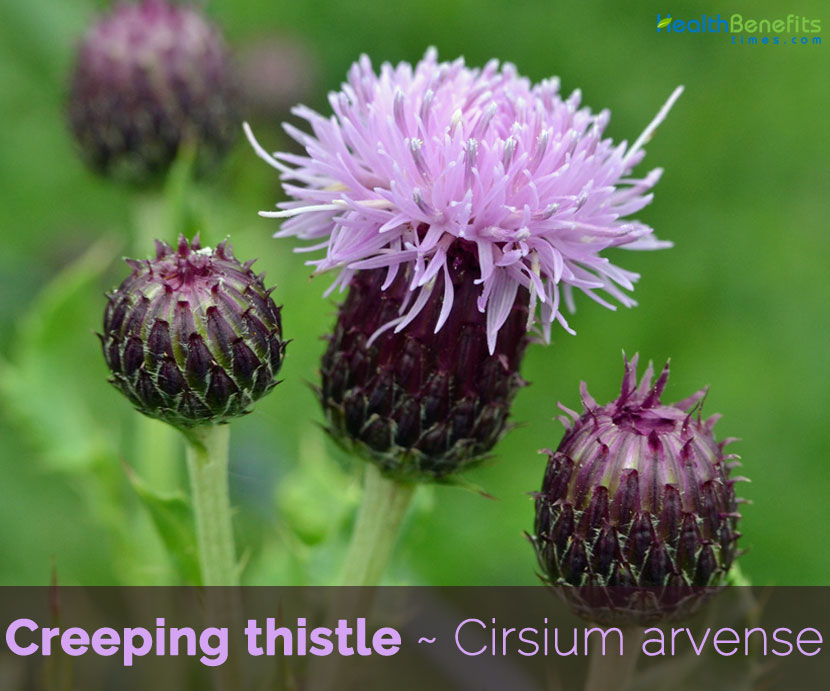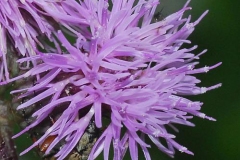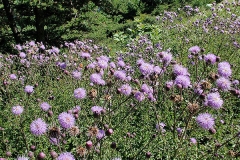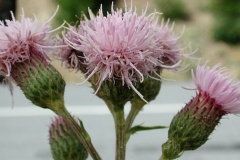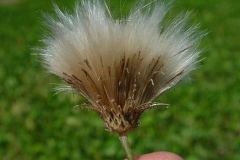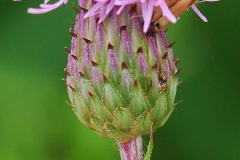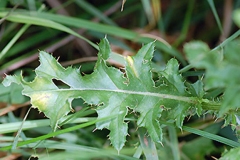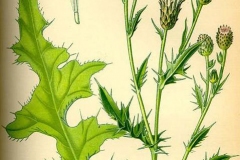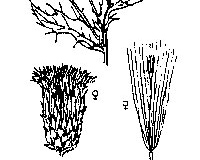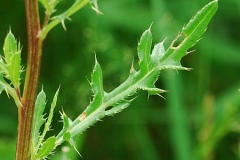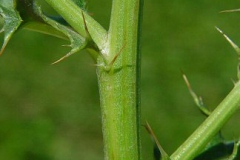| Creeping thistle Quick Facts | |
|---|---|
| Name: | Creeping thistle |
| Scientific Name: | Cirsium arvense |
| Origin | Southeastern Europe and the eastern Mediterranean area |
| Colors | Straw or light-brown |
| Shapes | Pappus copious, white, feathery, 20-30 mm long on mature achenes |
| Health benefits | Beneficial for toothache, indigestion, rheumatic joint pains, bleeding piles and treat worms in children |
| Name | Creeping thistle |
|---|---|
| Scientific Name | Cirsium arvense |
| Native | Southeastern Europe and the eastern Mediterranean area, and was probably introduced to North America. In addition to North America, Canada thistle is invasive in northern and southern Africa, the Middle East, Japan, India, New Zealand, Australia, and South America |
| Common Names | Creeping thistle, Field thistle, Californian thistle, Canadian thistle, lettuce from hell thistle, corn thistle, cursed thistle, field thistle, green thistle, hard thistle, perennial thistle, prickly thistle, small-flowered thistle, way thistle, Cardo cundidor, Choussio, Ciji, Da khawarak azghai, Honghuamiao,Koygocerten, Koygocuren, Ohakas, Ohtja, Perticone, Stioppone, Stramontano, stinger-needles, boar thistle, bull thistle, California thistle, Canada thistle, perennial creeping thistle, swamp thistle |
| Name in Other Languages | Albanian: Gjembi i arave, cirza e arave, perenik Armenian: Tatask aleher (Տատասկ ալեհեր), Tatask dashtayin (Տատասկ դաշտային) Azerbaijan: Bozumtul gangal (Бозумтул гангал), Chöl gangal (Чөл гангал) Arabic: Qaswan haqlay (قصوان حقلي) Bashkir: Baҫıw bïlsäne (Баҫыу билсәне) Belarusian: Badziak paliavy (Бадзяк палявы) Bosnian: Pužući čičak Breton: Dreinaskol Bulgarian: obiknovena palamida (обикновена паламида), Polska palamida (Полска паламида) Catalan: Calcida, Calciga, Carsos, calsida, calsidas, calcida vera, cardet Corsican: Cardigliola Croatian: Badilj, Bodeča neža, Korienopuzni osjak, Ošljak, Poljski osjak, Stričnjak, Vrisak, Žulj Czech: Pchá, pcháč oset Danish: Ager-tidsel, Eng-Storkenæb, Fjeld-Ribs, Guld-ribs, Liden Storkenæb, Pyrenæisk Storkenæb, Russisk storkenæb, Mark tidsel Dutch: Akkerdistel, distel English: California thistle, Canada thistle, Canadian thistle, Boar thistle, Creeping thistle, Field thistle, Perennial thistle, Cally thistle, Californian thistle, Estonian: Põldohakas Euskera: Carduba, kardulatza, kardu-latza Finnish: Kyläkurjenpolvi, Pihakurjenpolvi, Pyreneittenkurjenpolvi, Taikinamarja, Pelto-ohdake, French: Chardon des champs, Chardon du Canada, Cirse des champs, Circe des champs, sarrette des champs, Chardon des vignes, Herbe aux varices, Sarette Galician: Cardo cundidor, cardo hemorroidal, Feochadán reatha German: Acker-Kratzdistel, Ackerdistel, Feldkratzdistel Georgian: Tetri nari (თეთრი ნარი) Greek: Kírsio (κίρσιο) High Aragonese: Cardo triguero Hungarian: Mezei aszat Icelandic: Þistill Irish: Feochadán reatha Israel (Hebrew): קוצן השדה Italian: Cardo campestre, Scardaccione, Scorpione, Stoppione, cardo emorroidale Japanese: Ezonokitsuneazami (エゾノキツネアザミ), seiyôtogeazami (セイヨウトゲアザミ) Latvian: Tīruma dadzis, tīruma usne Lithuanian: Dirvinė usnis Majorcan: Calcida, calcides, calciga, calsiga, calsigues Moldovian: Pelemide de-kymp (Пэлэмидэ де-кымп), Pelamida keruntu (Пэлэмидэ кэрунтэ) Pelemide syetoase (Пэлэмидэ сетоасэ) Netherlands: Akkervederdistel Norwegian: Alperips, Askerstorkenebb, Engstorkenebb, Småstorkenebb, Åkertistel Occitan: Caucida, Caussido Ossetian: Huımon sındz (Хуымон сындз) Persian: خارلته Polish: Ostrożeń polny Portuguese: Cardo-das-vinhas, cardo-canadense, cardinho; cardinho das almorranas; cardo-hemorroidal, cardo-rasteiro Romanian: Pălămidă, pălămidă căruntă, pălămidă de cîmp, pălămidă setoasă Russian: Bodyak polevoy (Бодяк полевой), Bodyak sedoy (Бодяк седой), Bodyak shchetinistyy (Бодяк щетинистый), bodyak polevoy (бодяк полевой), ozot rozovyy (озот розовый) Serbian: Palamida (паламида), njivska palamida (њивска пачамида) Slovak: Pichliač poľný Slovenian: Njivski osat South Africa: Kanadese dissel Spanish: Aprepuños, burrero, cardo, cardillo, cardo blanco, Cardo cundidor, Cardo hemorroidal, Cardo oloroso, Ramoncillo negro, cardo condidor; cardo de las Pelotas, cardo oloroso, cardo trigal, cardo triguero, ginetes, ramoncillo oloroso, cardo borriquero, cardo canadiense, cardo de barbecho, cardo heredero, cardo negral, chupaderos, ginetes, negrillo, serrilla, cardo negro Swedish: Gullrips, Måbär, Ryssnäva, Skuggnäva, Sparvnäva, Pelto-ohdake, Ängsnäva, Åkertistel Turkish: Köygöçerten Ukrainian: Budyak polʹovyy (Будяк польовий), Osot polʹovyy (Осот польовий), Osot syvyy (Осот сивий), Osot sçetinistiy (Осот щетинистий) Valencian: Calcida, calsida, cart calcida, lletugueta de séquia Walloon: Tcherdon d’ tchamp Welsh: Ysgallen y maes Western Frisian: Finnestikel Yugoslavia: Palamida |
| Plant Growth Habit | Patch forming, herbaceous, rhizomatous creeping perennial |
| Growing Climates | Found in both disturbed (tilled) and no-tillage agricultural fields, Arable land, roadsides, cultivated land, stream banks, ditches, lakeshores, seashores, sand dunes and other open sandy areas, in clear cuts and forest openings, and in wet and wet-mesic grasslands, prairie potholes, overgrazed pastures, meadows, fence rows, campgrounds, road building and pasture |
| Soil | Grows on all waterlogged, poorly aerated, and peat soils, including clay, clay loam, silt loam, sandy loam, sandy clay, sand dunes, gravel, limestone, and chalk. It also grows best on limestone soils with abundant moisture |
| Plant Size | 1 to 6.5 feet (0.3-2 m) tall |
| Root | Deep and wide-spreading root system with a slender taproot and far-creeping lateral roots |
| Stem | 30–150 cm, slender green, and freely branched, smooth and glabrous (having no trichomes or glaucousness), mostly without spiny wings. |
| Leaf | Alternate, the base sessile and clasping or shortly decurrent; leaves generally oblong in outline, margin variable from entire to deeply pinnately segmented, spiny. Leaves are 1.2 to 7 inches (3-18 cm) long and 0.2 to 2.4 inches (0.5-6 cm) wide |
| Flowering season | July to September |
| Flower | Plants are polygamo-dioecious, thus there are male and female plants |
| Fruit Shape & Size | Achenes are tiny, 2-3 mm (0.1 in.) long and about 1 mm (0.04 in.) in diameter, and have a white to light brown pappus attached |
| Fruit Color | Straw or light-brown |
| Seed | 0.09 to 0.2 inch (2.4-5 mm) long, and 0.04 inch (1 mm) in diameter with a pappus of feathery bristles |
| Propagation | By seed, root buds and rhizomes |
| Season | August to October |
Root and Stem
The plant has a deep and wide-spreading root system with a slender taproot and far-creeping lateral roots. It often forms large patches, and individual clones may reach 115 feet (35 m) in diameter. Most Canada thistle roots are in the top 0.7 to 2 feet (0.2-0.6 m) of soil, but roots can extend as deep as 6.5 to 22 feet (2-6.75 m). Stems are 30–150 cm, slender green, and freely branched, smooth and glabrous (having no trichomes or glaucousness), mostly without spiny wings.
Leaves
Leaves are alternate on the stem with their base sessile and clasping or shortly decurrent. The leaves are very spiny, lobed, and up to 15–20 cm long and 2–3 cm broad (smaller on the upper part of the flower stem). They are dark green and lanceolate to oblong-lanceolate. They are glabrous above, but their undersides have short, white hairs. They may be pinnatifid and very prickly. Basal leaves are 5-8 in. (12-20 cm) long. Leaf characteristics are variable across different varieties and subspecies.
Flower
The inflorescence is 10–22 mm (0.39–0.87 in) in diameter, pink-purple, with all the florets of similar form (no division into disc and ray florets). The plants are polygamo-dioecious, thus there are male and female plants. The female inflorescences are flask-shaped, 1-1.5 cm (0.4-0.6 in.) in diameter, and 1-2 cm (0.4-0.75 in.) tall. The female flowers have a fragrance, while the male flowers do not. The male flowers are more globose in shape than the female flowers and are smaller. The flowers are usually purple in color, but can be pink or white. The plant is in bloom from June to August.
The fruits (achenes) are tiny, 2-3 mm (0.1 in.) long and about 1 mm (0.04 in.) in diameter, and have a white to light brown pappus attached. Seeds are 4–5 mm long, with a feathery pappus which assists in wind dispersal. One to 5 flower heads occur per branch, with plants in very favorable conditions producing up to 100 heads per shoot. Each head contains an average of 100 florets. Average seed production per plant has been estimated at 1530. More seeds are produced when male and female plants are closer together, as flowers are primarily insect-pollinated.
Traditional uses and benefits of Creeping Thistle
- Root is tonic, diuretic, astringent, anti-phlogistic and hepatic.
- It has been chewed as a remedy for toothache.
- Decoction of the roots has been used to treat worms in children.
- Paste of the roots, combined with an equal quantity of the root paste of Amaranthus spinosus, is used in the treatment of indigestion.
- Plant consists of a volatile alkaloid and a glycoside called cnicin, which has emetic and emmenogogue properties.
- Leaves are anti-phlogistic.
- They cause inflammation and have irritating properties.
- Common thistle roots have also been used as a poultice and a decoction prepared using the plant too is used as a poultice to treat aching jaws.
- Hot infusion prepared with the whole common thistle plant has been traditionally used to treat rheumatic joint pains.
- Decoction prepared with the whole plant has been used internally as well as externally to heal bleeding piles.
Culinary Uses
- Root of first year plants can be consumed raw or cooked.
- Nutritious but rather bland, they are best used in a mixture with other vegetables.
- Stems are peeled and cooked like asparagus or rhubarb.
- Leaves can be consumed raw or cooked.
- It has fairly bland flavor, but the prickles need to be removed before the leaves can be eaten.
- Leaves are also used to coagulate plant milks etc.
References:
https://www.itis.gov/servlet/SingleRpt/SingleRpt?search_topic=TSN&search_value=36335#null
https://pfaf.org/user/plant.aspx?LatinName=Cirsium+arvense
https://www.cabi.org/isc/datasheet/13628
http://www.floracatalana.net/cirsium-arvense-l-scop
https://plants.usda.gov/core/profile?symbol=CIAR4
https://www.invasiveplantatlas.org/subject.html?sub=2792
https://www.fs.fed.us/database/feis/plants/forb/cirarv/all.html
https://www.eddmaps.org/ipane/ipanespecies/herbs/cirsium_arvense.htm
https://npgsweb.ars-grin.gov/gringlobal/taxonomydetail.aspx?100755
http://www.iucngisd.org/gisd/species.php?sc=413
http://www.theplantlist.org/tpl1.1/record/gcc-106632
https://en.wikipedia.org/wiki/Cirsium_arvense
https://www.fs.usda.gov/Internet/FSE_DOCUMENTS/stelprdb5410109.pdf
http://www.eu-nomen.eu/portal/taxon.php?GUID=1F1E43F3-6AB7-4920-83D0-2F53C2D7AACA#collapse
https://www.flowersofindia.net/catalog/slides/Creeping%20Thistle.html


